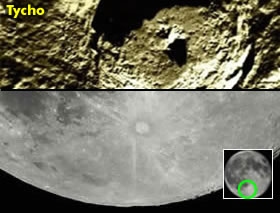Craters
2.3 - Be able to recognise the appearance of the principal naked-eye lunar surface formations (continued in 2.4)2.4 - Understand the structure and origin of the principal naked-eye lunar surface formations, including:
a - craters
The Moon, like most rocky objects in the solar system, has many craters on its surface. These are primarily impact features caused by meteorites or comets colliding with the Moon.
It is believed that most of these craters are ancient and formed during the Moon's early evolution through a heavy bombardment of impacts from material left over from the Sun's accretion disc.
Over 30,000 craters can be observed telescopically but there are vast numbers visible only from Moon probes or satellites.
Craters can best be seen when the Moon is not full so that shadows emphasise their width and depth.
The deepest crater, Newton, lies near the South Pole and its walls are 29,000 ft from the inside of the crater. This is as deep as Mount Everest is high on Earth. The centre of Newton is so deep it receives no light from the Sun. It was thought that craters such as these may contain frozen water deposited from comets that did not get evaporated by the Sun's heat.
Craters typically consist of a raised wall or rim. A rampart (slope) on the inside leads to the crater floor which is below the outside terrain. Often, they have a central peak. Some craters can also be caused by volcanic activity.
Geological process on Earth, and some other bodies in the Solar System, have disguised or hidden many of the impacts we have received over the last 4.5 billion years. The Earth also possesses a strong magnetic field and atmosphere, that the Moon does not have, that protects it from smaller meteorites.
Rays
We can see an interesting feature emanating from some craters when the Moon is near its full phase, notably Tycho and Copernicus. These are rays that spread out in different directions from the craters. These bright streaks are thought to be surface material deposited when the craters were first formed.
Interactive
Questions
- How are craters formed?
- Describe the appearance of an average lunar crater.
Summary
While some astronomers first thought craters were a result of volcanism, today we know the majority are impact craters.
Did you know?
- The diameter of the largest crater on the Moon is 231 kilometres across.
- Over ½ a million craters on the Moon can be seen from Earth.
Links
Lunar Impact Crater Geology & Structure Crater information





 | © All Rights Reserved |
| © All Rights Reserved |